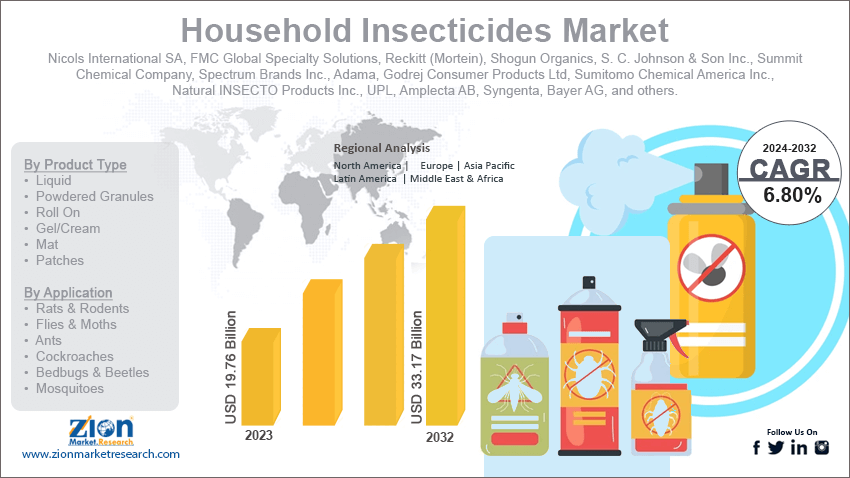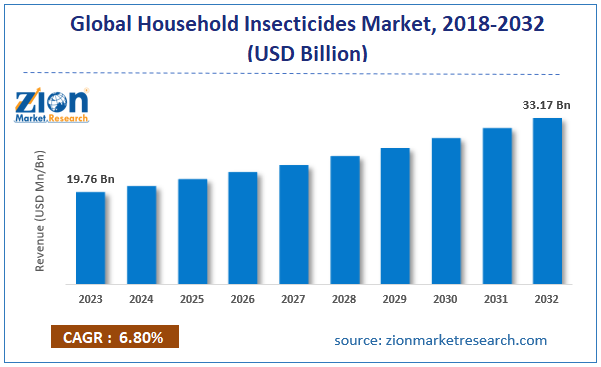Household Insecticides Market Size, Share, Trends, Growth 2032

Household Insecticides Market By Nature (Synthetic and Natural), By Product Type (Liquid, Powdered Granules, Roll On, Gel/Cream, Mat, and Patches), By Application (Rats & Rodents, Flies & Moths, Ants, Cockroaches, Bedbugs & Beetles, Mosquitoes, and Others), By Sales Channel (Supermarket, Store-Based Retailing, Online Retailers, Departmental Stores, Drug Stores & Pharmacy, and Others), and By Region - Global and Regional Industry Overview, Market Intelligence, Comprehensive Analysis, Historical Data, and Forecasts 2024 - 2032
| Market Size in 2023 | Market Forecast in 2032 | CAGR (in %) | Base Year |
|---|---|---|---|
| USD 19.76 Billion | USD 33.17 Billion | 6.80% | 2023 |
Household Insecticides Industry Prospective:
The global household insecticides market size was worth around USD 19.76 billion in 2023 and is predicted to grow to around USD 33.17 billion by 2032 with a compound annual growth rate (CAGR) of roughly 6.80% between 2024 and 2032.
Household Insecticides Market: Overview
Household insecticides are specially designed to be used in indoor settings. They are not as chemically potent as insecticides curated for outdoor applications. According to market analysis, indoor insecticides should only be used in dust, spray, or bait format and they should be marketed as in-home insecticides.
Furthermore, market experts suggest that the application of household insecticides should be considered as a last resort or as a complementary step to safer options, such as manual disposal or non-chemical methods. The household insecticides market is currently dominated by ready-to-use products that can be directly used from the packaging and do not require additional steps before they are applied. Currently, the industry is filled with a growing number of household insecticide providers.
However, the application of these chemicals is widely regulated worldwide which is one of the most significant growth barriers for the industry players. In addition, ingestion or inhalation of household insecticides can be dangerous to human health, especially children. The products available in the market are broadly divided into two categories that are non-residual and residual depending on how long the chemicals remain active after application. During the forecast period, the industry is expected to witness high growth with the growing population of highly resistant mosquitoes and cockroaches around the globe.
Key Insights:
- As per the analysis shared by our research analyst, the global household insecticides market is estimated to grow annually at a CAGR of around 6.80% over the forecast period (2024-2032)
- In terms of revenue, the global household insecticides market size was valued at around USD 19.76 billion in 2023 and is projected to reach USD 33.17 billion by 2032.
- The household insecticides market is projected to grow at a significant rate due to the rising level of mosquito and cockroach populations worldwide.
- Based on nature, the natural segment is growing at a high rate and will continue to dominate the global market as per industry projections.
- Based on the application, the mosquitoes segment is anticipated to command the largest market share.
- Based on region, Asia-Pacific is projected to dominate the global market during the forecast period.
Household Insecticides Market: Growth Drivers
Rising level of mosquito and cockroach population worldwide to drive market demand rate
The global household insecticides market is expected to grow due to the growing population of mosquitoes and cockroaches worldwide. According to Vector Disease Control International, mosquito populations are widely diverse, and in certain cases, the mosquito species can coexist in a single ecosystem.
In addition, extensive research indicates that mosquitoes are becoming resilient to current insecticides due to extensive exposure over a long period. According to the US Department of Agriculture, mosquitoes show extremely high resistance to commonly used insecticides and more potent methods have to be applied to kill the insects. The growing number of malaria and dengue cases worldwide has become a major cause of concern for healthcare authorities.
In addition to this, the impact of dengue fever on human health is becoming more serious with every passing year. In 2024, around 10,000 deaths were reported due to dengue. Dengue is also known as break-bone fever due to its serious impact on the overall well-being of the patient. On the other hand, the cockroach population is also on the rise. Cockroaches are known to cause several health concerns, including asthma & allergies, typhoid fever, salmonellosis, dysentery, cholera, and listeriosis.
Household Insecticides Market: Restraints
Health concerns associated with exposure to insecticides will limit the industry’s growth rate
The global household insecticides market is projected to be limited due to the several health concerns associated with long-term exposure to the chemicals and ingredients of insecticides. These products are made using harsh chemicals such as carbamates and organophosphates. Short-term exposure to the chemicals is associated with skin & eye irritation and respiratory concerns.
Additionally, long-term exposure can cause cancer risks & hormonal disruptions and affect the overall immune system. Studies have proven that persistent exposure to household insecticides can cause serious health exposure even leading to death.
Household Insecticides Market: Opportunities
Increasing the launch of new products in the market to generate expansion possibilities
The global household insecticides industry is expected to generate growth opportunities due to the increasing introduction of new products in the market. With insects becoming resilient to existing methods of termination, the scope for the development of new products has become more urgent.
For instance, the industry is currently witnessing a growing demand for chemical-free and natural household insecticides that kill insects but do not leave harmful traces for humans. In January 2025, Nature’s Dome, a leading developer of insect-terminating solutions, announced the launch of a new Bed Bug Spray. The novel product is eco-friendly and prioritizes the safety of the residents. Furthermore, it is expected to promote sustainability due to the use of non-toxic ingredients during the production process.
Increasing proliferation of e-commerce channels to generate more growth avenues
The increasing expansion of the e-commerce industry and online sales platform will generate new expansion possibilities for the global household insecticides market. Product manufacturers are actively investing in creating online profiles for the products and leveraging the extensive reach of established e-commerce platforms such as Amazon and other regional channels.
The global e-commerce industry is one of the fastest-growing sectors with increasing investments worldwide. Some of the key areas of focus for an online sales portal include improved customer service, quick delivery, easy return or exchange policies, and the use of more advanced technologies for a seamless shopping experience. Furthermore, the development of e-commerce applications compatible with mobile phones and other wearables will be helpful for the producers of household insecticides in the coming years.
Household Insecticides Market: Challenges
Regulatory and labeling concerns remain top challenges for the industry players
The global household insecticide industry is expected to be challenged by the presence of extensive regulations regarding the production and sale of final goods. In addition, labeling complexities can also limit the industry’s expansion trajectory.
For instance, market players must adhere to legal labeling requirements. In case of non-compliance companies may face strict penalties. Another crucial challenge includes the growing use of do-it-yourself or home remedies for managing insecticide infestation.
 Request Free Sample
Request Free Sample
Household Insecticides Market: Report Scope
| Report Attributes | Report Details |
|---|---|
| Report Name | Household Insecticides Market |
| Market Size in 2023 | USD 19.76 Billion |
| Market Forecast in 2032 | USD 33.17 Billion |
| Growth Rate | CAGR of 6.80% |
| Number of Pages | 217 |
| Key Companies Covered | Nicols International SA, FMC Global Specialty Solutions, Reckitt (Mortein), Shogun Organics, S. C. Johnson & Son Inc., Summit Chemical Company, Spectrum Brands Inc., Adama, Godrej Consumer Products Ltd, Sumitomo Chemical America Inc., Natural INSECTO Products Inc., UPL, Amplecta AB, Syngenta, Bayer AG, and others. |
| Segments Covered | By Nature, By Product Type, By Application, By Sales Channel, and By Region |
| Regions Covered | North America, Europe, Asia Pacific (APAC), Latin America, Middle East, and Africa (MEA) |
| Base Year | 2023 |
| Historical Year | 2018 to 2022 |
| Forecast Year | 2024 - 2032 |
| Customization Scope | Avail customized purchase options to meet your exact research needs. Request For Customization |
Household Insecticides Market: Segmentation
The global household insecticides market is segmented based on nature, product type, application, sales channel, and region.
Based on nature, the global market segments are synthetic and natural. In 2023, the highest growth was listed in the natural segment. It dominated nearly 70.01% of the total market share. Natural insecticides are only harmful to insects and do not pose any significant threat to human lives. Additionally, they are safer to use. The growing development of more effective natural insecticides will create an additional demand rate in the coming years. Synthetic insecticides face extensive regulatory limitations causing restricted growth.
Based on the product type, the global household insecticides industry is divided into liquid, powdered, granules, roll-on, gel/cream, mat, and patches.
Based on the application, the global market divisions are rats & rodents, flies & moths, ants, cockroaches, bedbugs & beetles, mosquitoes, and others. In 2023, the highest revenue was generated by the mosquitoes segment. It held control over 34.05% of the final revenue. The growing number of diseases caused by mosquitoes worldwide has caused more demand for effective treatments. In addition to this, mosquito species are becoming more resilient to the current methods of eliminating pests and insects.
Based on the sales channels, the global market segments are supermarkets, store-based retailing, online retailers, departmental stores, drug stores & pharmacies, and others.
Household Insecticides Market: Regional Analysis
Asia-Pacific to deliver the highest revenue during the forecast period
The global household insecticides market is expected to be led by Asia-Pacific during the forecast period. In 2023, the region accounted for nearly 34.09% of the global market share with countries such as India and China leading the regional market. The growing prevalence of serious diseases caused by insects and pests within residential and commercial spaces has created more demand for household insecticides. Between 2005 and 2023, China reported nearly 110,000 dengue fever cases.
Similarly, India has been witnessing an exceptional rise in the number of dengue cases countrywide. The growing efforts by regional governments to improve overall healthcare infrastructure in the local communities will further guide higher growth in Asia-Pacific.
Europe has a high demand for household insecticides. The regional market is heavily regulated which has shaped Europe’s growth trajectory. In March 2024, regional player Syngenta announced the launch of Advion Trio cockroach gel bait. The product is developed with the aid of pest management professionals (PMPs) and aims to inhibit cockroaches' growth at a very early stage of their lifecycle. In addition to this, the regional market is enjoying more demand for natural insecticides due to higher consumer awareness and focus on sustainable growth.
Household Insecticides Market: Competitive Analysis
The global household insecticides market is led by players like:
- Nicols International SA
- FMC Global Specialty Solutions
- Reckitt (Mortein)
- Shogun Organics
- S. C. Johnson & Son Inc.
- Summit Chemical Company
- Spectrum Brands Inc.
- Adama
- Godrej Consumer Products Ltd
- Sumitomo Chemical America Inc.
- Natural INSECTO Products Inc.
- UPL
- Amplecta AB
- Syngenta
- Bayer AG
The global household insecticides market is segmented as follows:
By Nature
- Synthetic
- Natural
By Product Type
- Liquid
- Powdered Granules
- Roll On
- Gel/Cream
- Mat
- Patches
By Application
- Rats & Rodents
- Flies & Moths
- Ants
- Cockroaches
- Bedbugs & Beetles
- Mosquitoes
- Others
By Sales Channel
- Supermarket
- Store-Based Retailing
- Online Retailers
- Departmental Stores
- Drug Stores & Pharmacy
- Others
By Region
- North America
- The U.S.
- Canada
- Europe
- France
- The UK
- Spain
- Germany
- Italy
- Rest of Europe
- Asia Pacific
- China
- Japan
- India
- South Korea
- Southeast Asia
- Rest of Asia Pacific
- Latin America
- Brazil
- Mexico
- Rest of Latin America
- Middle East & Africa
- GCC
- South Africa
- Rest of Middle East & Africa
Table Of Content
Methodology
FrequentlyAsked Questions
Household insecticides are specially designed to be used in indoor settings. They are not as chemically potent as insecticides curated for outdoor applications.
The global household insecticides market is expected to grow due to the growing population of mosquitoes and cockroaches worldwide.
According to study, the global household insecticides market size was worth around USD 19.76 billion in 2023 and is predicted to grow to around USD 33.17 billion by 2032.
The CAGR value of the household insecticides market is expected to be around 6.80% during 2024-2032.
The global household insecticides market is expected to be led by Asia-Pacific during the forecast period.
The global household insecticides market is led by players like Nicols International SA, FMC Global Specialty Solutions, Reckitt (Mortein), Shogun Organics, S. C. Johnson & Son, Inc., Summit Chemical Company, Spectrum Brands, Inc., Adama, Godrej Consumer Products Ltd, Sumitomo Chemical America, Inc., Natural INSECTO Products, Inc., UPL, Amplecta AB, Syngenta and Bayer AG.
The report explores crucial aspects of the household insecticides market including a detailed discussion of existing growth factors and restraints while also browsing future growth opportunities and challenges that impact the market.
RelatedNews
HappyClients
Zion Market Research
Tel: +1 (302) 444-0166
USA/Canada Toll Free No.+1 (855) 465-4651
3rd Floor,
Mrunal Paradise, Opp Maharaja Hotel,
Pimple Gurav, Pune 411061,
Maharashtra, India
Phone No +91 7768 006 007, +91 7768 006 008
US OFFICE NO +1 (302) 444-0166
US/CAN TOLL FREE +1 (855) 465-4651
Email: sales@zionmarketresearch.com
We have secured system to process your transaction.
Our support available to help you 24 hours a day, five days a week.
Monday - Friday: 9AM - 6PM
Saturday - Sunday: Closed






